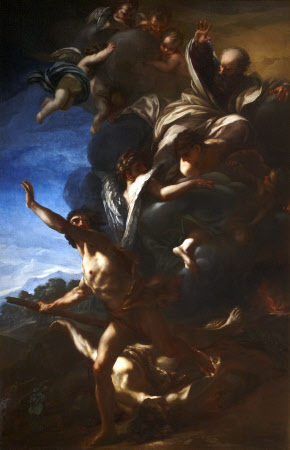Cain fleeing from the Sight of God after the Death of Abel
Benedetto Luti (Florence 1666 – Rome 1724)
Category
Art / Oil paintings
Date
1692
Materials
Oil on canvas
Measurements
3099 x 1829 mm (122 x 72 in)
Place of origin
Italy
Order this imageCollection
Kedleston Hall, Derbyshire
NT 108850
Summary
Oil painting on canvas, Cain fleeing from the Sight of God after the Death of Abel by Benedetto Luti (Florence 1666 – Rome 1724), 1692. Cain running across the body of Abel, angels and God figure above. Cain, grasping a stick in his right hand, and raising his left arm to ward off God’s wrath, flees to the left, with God the Father with upraised right hand, in clouds supported by angels and putti angels, above him and behind him to the right. The painting has much stronger chiaroscuro than is suggested by either drawings or prints. Although Luti was the teacher of the architect William Kent, and one of the last major representatives of the Baroque tradition in Rome, this painting and its pendant (KED/P/156) were acquired at a sale held by the art-dealer William Kent, who was no relation of the architect, in 1757. This one cost 85 guineas. They are both shown in ‘Athenian’ Stuart’s design for an end wall of a State Room, although they may be the ‘best pictures’ that Adam mocked him for proposing to cut down to fit his schemes. Benedetto Luti was one of the most important artists active in Rome at the outset of the eighteenth century. He was trained in Florence under the direction of Anton Domenico Gabbiani and consequently absorbed the dynamic baroque style of Pietro da Cortona and his followers. In 1690 he left Florence for Rome where, in 1692, he made his name in the annual Saint Bartholomew’s Day exhibition with this monumental painting. In the same year he won first prize in the first class of painting in the Concorso Clementino at the Accademia di San Luca. Luti worked for various prominent Roman families and also for the Church. He was invited to take part in the most significant papal commission in Rome in the first quarter of the eighteenth-century, the series of paintings of Old Testament prophets above the nave arcade in Saint John Lateran .
Provenance
Exhibited at Saint Bartholomew’s Day exhibition, San Bartolommeo (not certain which, but probably San Bartolommeo dei Bergamaschi), Rome, 24 August 1692; painted in Rome in 1692 as a pendant to Christ and Mary Magdalene in the house of Simon for Luti’s first patron for Cardinal Giovanni Niccolò Berzighelli of Pisa (but domiciled in Florence); Ignatius Hugford, Florence by 1728;probably acquired from Ignatius Hugford, by the dealer William Kent, by whom offered at auction at Langford’s in February 1757; bought by Sir Nathaniel Curzon, 5th Bt, later 1st Baron Scarsdale (1726-1804), and hung since 1769 (it was not noticed by Horace Walpole on his visit in September 1768, but features in the 1st [1769] edition of the Catalogue) in the Withdrawing Room at Kedleston, along with its pendant, Christ and Mary Magdalen in the House of Simon Levi (KED/P/156) whose fate it has shared;recorded Old Kedleston Hall, Egmont, 1744; in the Kedleston Hall - Withdrawing Room in 1769; and thence by descent until bought with part of the contents of Kedleston with the aid of the National Heritage Memorial Fund in 1987 when the house and park were given to the National Trust by Francis Curzon, 3rd Viscount Scarsdale (1924-2000)
Credit line
Kedleston Hall, The Scarsdale Collection (acquired with the help of the National Heritage Memorial Fund and transferred to The National Trust in 1987)
Makers and roles
Benedetto Luti (Florence 1666 – Rome 1724), artist
References
[Anon], Serie degli uomini i più illustri in pittura, scultura, e architettura, (From the ‘Elogio di Benetto [sic] Luti’), Florence, vol.XII, 1775, p.134

